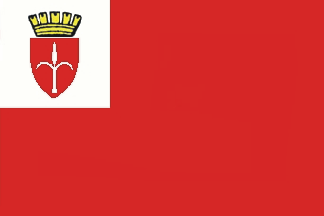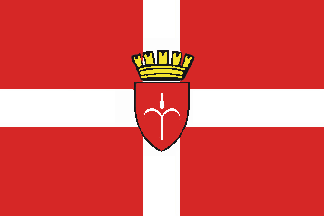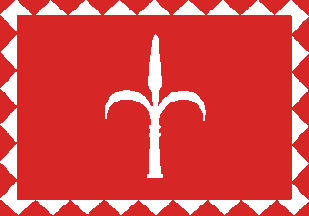
by Alex Belfi, 3 October 2000

Last modified: 2003-01-18 by dov gutterman
Keywords: italy | friuli-venezia giulia | trieste | spearhead | istria | free territory | spear | helberd |
Links: FOTW homepage |
search |
disclaimer and copyright |
write us |
mirrors
See also:
I was wandering, was this the flag of FTT Zone A, that is
under Italian/Allyed control. I have never seen (or can't
remember) reference to such flag used in FTT Zone B, that is one
that was under the administraton of Yugoslav Army (i.e. Tito's
partisans). Actually, I never heard of any flag ascribed to FTT
Zone B. However, most probably the well known Yugoslav flag with
stars, as well as the national flags with stars (Slovenian,
Italian and Croatia) would have been used. And, of course, the
red flag of Communist party .
The two zones of FTT were latter (1953, IIRC) incorporated in
Italy and Yugoslavia respectivly, with very minor border changes.
FTT Zones issued both stamps and banknotes. I do not remember
them quite vividly to claim anything, but there was not FTT flag
or CoA on them. I seem to remember one FTT Zone B stamp with
flag, but that one was pure red.
Zeljko Heimer , 24 September 1998
I believe the flag was the flag for the whole territory since
the constitution of the Free Territory of Trieste mentionned the
flag of the Territory as well as the coat of arms. But the flag
was certainly mainly used in the city of Trieste as this flag is
first a city flag.
Pascal Vagnat , 25 September 1998
The flag was in use as Free Terittory of Trieste flag from
1945 to 5 Octuber 1954.
Jaume Olle' , 5 November 1998
In the Belgian vexillological magazine Vexillinfo n°58 (March
1985), Aldo Ziggioto from Italy explains that he was in
Trieste in 1945. The First of May, the whole of the territory was
occupied by the Yugoslavian troops. In June, these had to quit
Trieste which was then occupied by the Western Allies. Since that
time, the territory was divided in two parts: the A zone (Trieste
and surroundings: Allied Military Government, then Free Territory
of Trieste) and B zone (part of Istria,
governed by the Yugoslavs).
On the paper, the two zones formed together a territory with an
autonomous administration. In reality, Yugoslavia immediately
considered the B zone as a "free" zone and annexed it
to the Popular Republic of Yugoslavia.
Ziggioto says that in the B zone, the Italian tricolour was
strictly forbidden, except when, but rarely, it bore a red star
fimbriated gold in the middle (see
here). In the other hand, the Slavs, who were relatively
numerous in Trieste and in its surroundings, lived in a
"democratic state" and could freely use the Yugoslav
flag during demonstrations. In fact nobody knows that there was a
specific flag for the Free territory of Trieste, for that there
was only one "Trieste" flag made: the unique exemplar
of the flag was flying above the castle of Duino.
In Flagmaster 043 and Vexillinfo n°48 of May 1984 p.51, another
informations: Mr. J.R. Allen says in the first that the
flag of the Free Territory of Trieste was also flying only in the
A zone occupied by the American-British forces and especially
above the castle of Duino, which was the residence of the
Military Cdt of the said zone, the General Officer Commandind
BETFOR (British Element Trieste Force). The flag was lowered on
the 5th of October 1954 when the Italians regained this part of
the territory. It is kept now in the collections of the Imperial
War Museum in London.
Pascal Vagnat , 13 November 1999
As far as I'm aware, it is true that there was no specific
flag for FTT. Zone B was not "imidiately annexed", at
least not in theory- it formed separate zone under military
administration, and as such issued it's own stamps and currency
until 1954 when FTT as a whole was disbanded and included formaly
in Italy and Yugoslavia.
Regarding the Italian flag with
"Yugoslav star", I belive that it was used in Zone
B quite often, together with other flags of peoples living there
- Croats and Slovenians, when appropriate, and when it was not
only the Yugoslav flag hosited. Though, I do not have any
documents by hand to support it.
Zeljko Heimer , 13 November 1999
Part of FTT Zone B is in Slovenia. To put it briefly, the FTT
was formed after the end of WWII and divided into Zone A under
Alied control and Zone B under the control of Yugoslav Army. The
situation remained so until mid-1950's (1956?) when it was agreed
that the Zone A is to be added to Italy and Zone B to Yugoslavia.
Some minor border corrections in favor of Zone B were made at the
time. The Zone B was divided between Yugoslav republics of
slovenia and Croatia according to the major population, Slovenia
gettin a small litoral around Koper, and Croatia getting the most
of Istria. The city of Trieste remianed in Italy (even if
Yugoslav politics of the time was strongly against it).
Zeljko Heimer, 7 October 2000
This is the official flag of the FTT, red with a white halberd
in the middle, usually 2/3 or 7/10. You could collect dozens of
types of Trieste halberds, but this is, as far as i know, the
most commonly used shape. It was used on all public buildings and
blockade places on borders with Italy and Yugoslavia. The same
flag was also used in Zone B, but a yugoslav flag and, often, an
italian flag with red star in the middle, were used at its sides.
The italian flag was strictly forbidden in both zones of the FTT,
especially in Zone B, but when displayed (in Zone B) with a red
star in the middle, it officially represented the
italian-speaking population of that territory, and it continued
to do so after Zone B was integrated in Yugoslavia; it stopped
waving when Yugoslavia collapsed in 1991.
The flag of the former FTT is today of common use in Trieste and
its surrounding area (i.e. the former Zone A), but, when
officially, together with the italian flag. Someone still
considers that if that flag is used as a stand-alone flag, it
might have a clear reference to the FTT and the independentist
movement. However, it waves on top of the communal tower.
Alex Belfi, 3 October 2000
A page from an italian dictionary (Il Nuovissimo Melzi, 1952)
displays the flags of all european countries including the above
flag of the FTT.
Alex Belfi, 3 October 2000
1) 
by Alex Belfi, 29 September 2000
2) 
by Alex Belfi, 29 September 2000
3) 
by Alex Belfi, 29 September 2000
As the idea of creating the FTT came out in july 1946, someone
thought to propose a flag for it; three proposals were made
before deciding to keep the flag that was already in use in the
territory. The coat of arms on the first and second proposal is
today the official coat of arms of the municipality of Trieste.
This coat of arms was also used before World War II, but most of
the times (and officially after 1933), it featured a fascio. The
third proposal is inspired by flags used in Trieste during the
austro-hungarian period , using red and white, which are the
colors of Trieste.
Alex Belfi, 29 September 2000
tr-03.gif)
by Alex Belfi, 29 September 2000
This weird symbol was used by U.S. forces in the FTT, from
1947 to 1954; it is made up of the blue background that, alone,
used to represent the 88th Infantry Reg.; as the FTT was
proclaimed on the 16th of September 1947, they added the coat of
arms in the middle, and a white border; a friend of mine owns an
original american jacket with this symbol on the sleeve. It was
also printed on official TRUST (Trieste United States Troops)
documents.
Alex Belfi, 29 September 2000